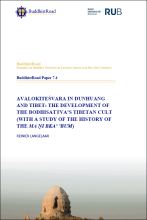BuddhistRoad Paper 7.4 "Avalokiteśvara in Dunhuang and Tibet: The Development of the Bodhisattva’s Tibetan Cult (with a Study of the History of the Ma ṇi bka’ ’bum)"
Synopsis
The period in which the famous Tibetan cult of the bodhisattva Avalokiteśvara (Tib. sPyan ras gzigs) took shape remains disputed. Some have sought his cult’s incipience towards the end of the second millennium or even at the dusk of the Tibetan Empire (ca. 7th c. to 842, Tib. Bod chen po), while others consider it the fruit of religious developments during Tibet’s so-called later propagation of Buddhism (from the late 10th/early 11th c. onward, Tib. phyi dar). This paper illuminates the matter by studying the textual history of two highly influential early Tibetan sources concerning this bodhisattva, the Ma ṇi bka’ ’bum [Collected Works on the Maṇi (Mantra)] and the bKa’ chems ka khol ma [Pillar Testament]. Diachronic analyses of these two works are important topics in their own right, yet also illuminate the growth of the distinctively Tibetan mythology that would come to surround Avalokiteśvara. In a bid to further draw out historical developments, findings from these two sources are presented in combination with Tibetan Dunhuang (敦煌) documents and Tibetan Plateau sources from the period of the later propagation of Buddhism in Tibet. This combined survey provides a more fine-grained view of Avalokiteśvara’s unparalleled rise in Tibetan religion. In the process, the article rewrites our understanding of the history of the Collected Works on the Maṇi (Mantra), while also developing new insights into the rise to prominence of the six-syllable mantra Oṃ ma ṇi pad me hūṃ, Avalokiteśvara’s growing roles in Tibetan history, as well as his relation to Amitābha/Amitāyus.
Chinese Translation
学界对于藏传佛教观音(藏文:sPyan ras gzigs)崇拜的形成时期仍然存在争议。一些人试图将其崇拜的起源追溯到第一千年的末期,甚至到吐蕃王朝末期(大约公元7世纪到842年,藏文: Bod chen po),而另一些人则认为它是所谓的藏传佛教后弘期(从10世纪末/11世纪初开始,藏文:phyi dar)的发展产物。本文通过研究《玛尼全集》(Collected Works on the Maṇi (Mantra))和《柱间史》(bKa’ chems ka khol ma)的文本历史来阐明这个问题,二者都是涉及观音信仰极具影响力的早期藏文材料。对这两个文本进行历时性分析本身就是重要的课题,同时也将阐明独特的藏族神话围绕观音信仰的发展。为了进一步揭示历史发展过程,本文将对这两个文本的发现与敦煌藏文文献以及后弘期青藏高原的资料结合起来。这种综合性研究为探讨观音信仰在藏传佛教中无出其右的发展提供更细致的视角。本研究重塑了我们对《玛尼全集》历史的理解,同时对六字真言“嗡嘛呢叭咪吽”(Oṃ maṇi padme hūṃ)的兴起、观音菩萨在藏族历史中日益增长的角色变化以及祂与阿弥陀佛/无量寿佛的关系有新的见解。

Downloads
Published
Categories
License

This work is licensed under a Creative Commons Attribution-NonCommercial-NoDerivatives 4.0 International License.

